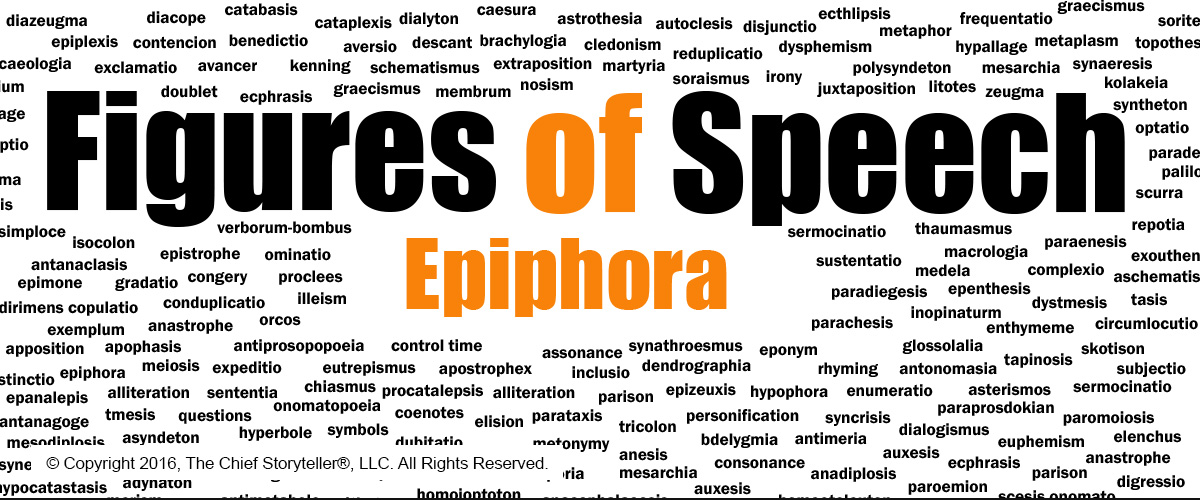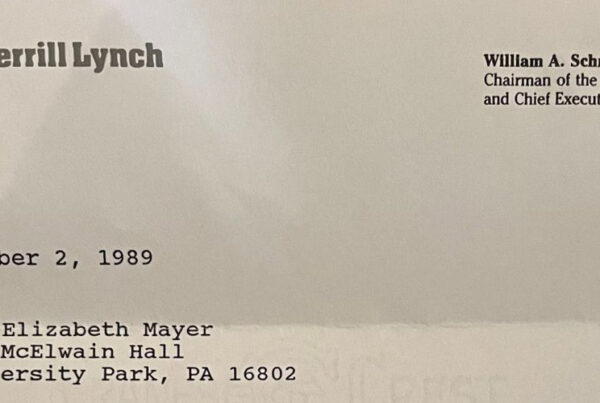
This blog post is about Epiphora, a Repetition Figure of Speech. It is part of a series on repetition. I share them as the English language has hundreds of literary devices to help you (dramatically) improve the effectiveness and impact of your various communications.
Repetition used well, strengthens your written and spoken narrative with emphasis and emotion. Repetition is by far, one of the most powerful of all figures of speech. Why? Because as human beings, we are programmed to recognize patterns and to pay attention to them.
While I include background information, Greek word derivation, and pronunciation, what is most important is the application of each figure of speech in your written, spoken, and social media communication.
I tell my consulting customers, workshop participants, coaching clients, and students (I’m an adjunct professor at The Robert H. Smith School of Business at the University of Maryland), the same thing:
“You never have to remember the actual Greek word for the figure of speech. Just remember the concept and application.”
Emphasis & Impact Figures of Speech include Anadiplosis, Anaphora, Asyndeton, Diacope, Epanalepsis, Epiphora, and Polysyndeton.
Amplification Figures of Speech include Auxesis and Epizeuxis,
Figures of Sound include Onomatopoeia.
Other Figures of Speech include Procatalepsis and Portmanteau.
There are three major sections:
- Figure of Speech. Includes a little background, usage, definition, pronunciation, other related figures of speech, and etymology.
- Usage Guidelines. Follow these guidelines to ensure maximum impact.
- Examples of Epiphora. Find examples from speeches, presentations, presidential addresses, poems, music, and more
1) EPIPHORA – REPETITION FIGURE OF SPEECH
The way you use Epiphora creates a deliberate pattern in how you use the word or words. The pattern could rhyme as well as it could lend itself to a familiar cadence as you speak, enabling an easy way to remember. With the examples below, see how the pattern becomes the theme, the hook, or the catch phrase of the speech or passage. You can also look to Epiphora as a way of creating a very memorable refrain or chorus such as in a song.
| Definition | Epiphora is a word or phrase repeated at the end of a successive phrase, clause, or sentence, two or more times |
| Pronunciation | ep – i – FOR – ah |
| Also Known as | Epistrophe or Antistrophe |
| Related to | Anaphora, Simploce |
| Etymology | Comes from the Greek word, ἐπιστροφή, which means “a bringing to or upon” |
2) USAGE GUIDELINES
Here is my own definition of Repetition.
Repetition is a literary device where a word or phrase is repeated two or more times to emphasize the point being made and/or emphasize the emotional feeling associated with the point being made. With more than 30 forms of repetition, it is more commonly thought of as a category rather than thought of as a single figure of speech.
Here are some guidelines for you to ensure Epiphora achieves your communication goals:
| Use Sparingly | Too much of one type of repetition will likely reduce its effectiveness and may cause your audience to miss your emphasis entirely as there are too many instances of your repetition. As such use Epiphora sparingly and for that matter, all of your figures of speech. |
| Choose a Simple Word or Phrase | If you were to analyze narratives where Epiphora is used, you would find the authors use simple words and simple phrases. You want to ensure your audience is able to readily remember your ideas. Simple always wins the day. See below for examples. |
| Use Your Orchestra |
In my training and teaching, I share specifics on how to use one’s voice to add (dramatic) impact to your spoken communication. Think of yourself as an orchestra with three main instruments: i) your Words; ii) your Body (Language); and iii) your Voice. Using your orchestra effectively, is what separates a good speaker from a great speaker. A good trainer from a great trainer. A good leader from a great leader. |
3) EXAMPLES OF EPIPHORA
Look at the examples below. See how Epiphora is used to dramatically increase the effectiveness and impact of your words. Then experiment, mixing and combining other figures of speech in your written, spoken, and social media communication.
Example 1: “Tuesdays with Morrie,” book by Mitch Albom
| Without Notation | “…There are a few rules I know to be true about love and marriage: If you don’t respect the other person, you’re gonna have a lot of trouble. If you don’t know how to compromise, you’re gonna have a lot of trouble. If you can’t talk openly about what goes on between you, you’re gonna have a lot of trouble. And if you don’t have a common set of values in life, you’re gonna have a lot of trouble. Your values must be alike.” |
| With Notation |
“…There are a few rules I know to be true about love and marriage: If you don’t respect the other person, { you’re gonna have a lot of trouble }. If you don’t know how to compromise, { you’re gonna have a lot of trouble }. If you can’t talk openly about what goes on between you, { you’re gonna have a lot of trouble }. And if you don’t have a common set of values in life, { you’re gonna have a lot of trouble }. Your values must be alike.” |
Example 2: Dr. Pepper Soft Drink Commercials from 1970’s
| Without Notation | “I’m a Pepper, he’s a Pepper, she’s a Pepper, we’re a Pepper. Wouldn’t you like to be a Pepper, too? Dr. Pepper.” |
| With Notation |
“I’m a { Pepper }, he’s a { Pepper }, she’s a { Pepper }, we’re a { Pepper }. Wouldn’t you like to be a { Pepper }, too? Dr. { Pepper }.” |
Example 3: President Abraham Lincoln, Gettysburg Address, 1863
| Without Notation | “…that government of the people, by the people, for the people, shall not perish from the earth.” |
| With Notation |
“…that government of { the people }, by { the people }, for { the people }, shall not perish from the earth.” |
Example 4: Dr. Martin Luther King Jr., “I Have a Dream,” August 1963
| Without Notation | “With this faith, we will be able to hew out of the mountain of despair a stone of hope. With this faith, we will be able to transform the jangling discords of our nation into a beautiful symphony of brotherhood. With this faith, we will be able to work together, to pray together, to struggle together, to go to jail together, to stand up for freedom together, knowing that we will be free one day.” |
| With Notation |
“With this faith, we will be able to hew out of the mountain of despair a stone of hope. With this faith, we will be able to transform the jangling discords of our nation into a beautiful symphony of brotherhood. With this faith, we will be able to work { together }, to pray { together }, to struggle { together }, to go to jail { together }, to stand up for freedom { together }, knowing that we will be free one day.” |
Example 5: Ralph Waldo Emerson
| Without Notation | “What lies behind us and what lies before us are tiny matters compared to what lies within us.” |
| With Notation |
“What lies behind { us } and what lies before { us } are tiny matters compared to what lies within { us }.” |
References: I use a combination of my experience, my personal library of books and journals, sources from the Internet, and my 710-plus page Story Elements Resource Guide. My favorite sources include, in alphabetical order: American Rhetoric, Encyclopedia Britannica, LitCharts, Literary Devices, Merriam-Webster Dictionary, Oxford English Dictionary, Silva Rhetoricae, and ThoughtCo. My favorite books include: A Handbook of Rhetorical Devices by Robert A. Harris; Elements of Eloquence by Mark Forsyth; and A Handlist of Rhetorical Terms, 2nd Edition by Richard A. Lanham.
Updated March 2019
Photography Source: Message Cloud/Word Cloud © Copyright 2019, The Chief Storyteller®, LLC. All Rights Reserved.
#chiefstoryteller #communication #figuresofspeech #language #rhetoric



